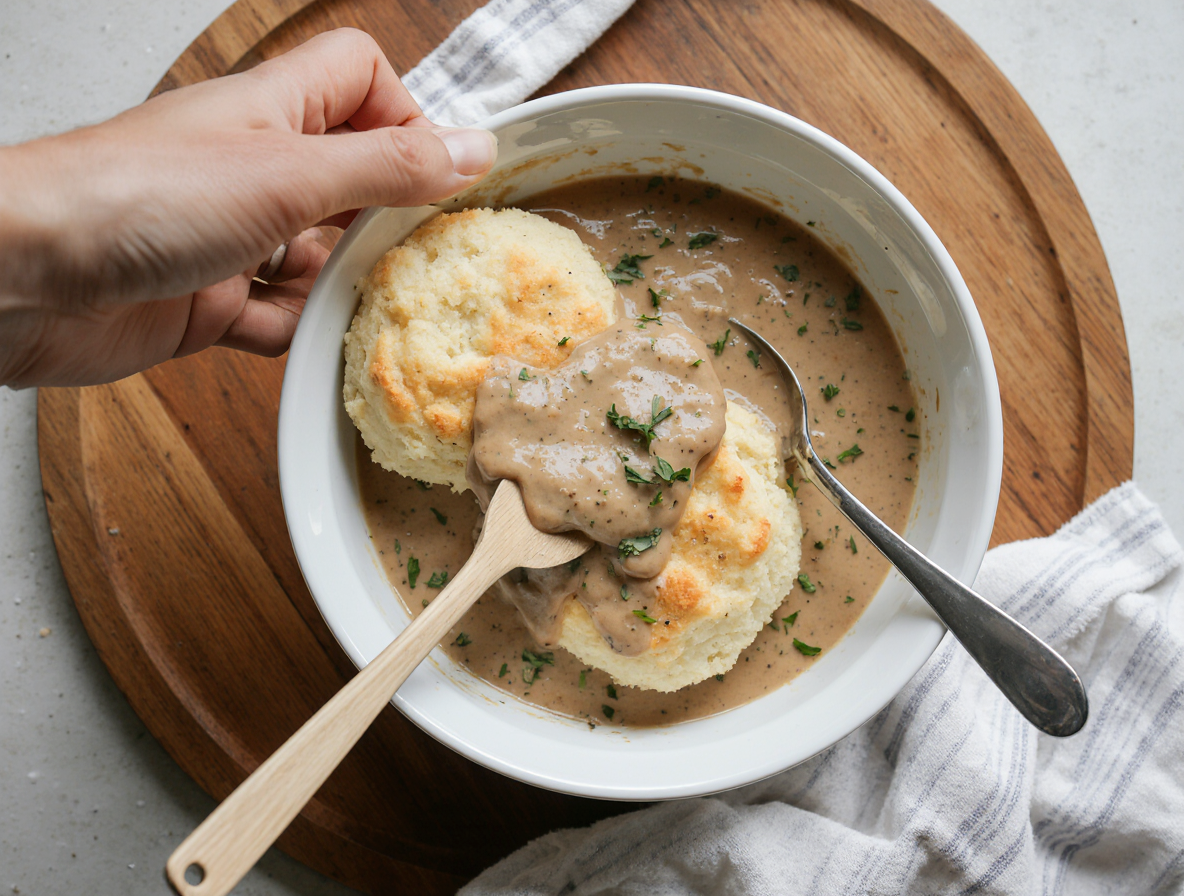The Secret to Perfect Biscuits and Gravy Recipe (Chef-Approved Method)
Biscuits and gravy recipe enthusiasts know there’s nothing quite as satisfying as this classic breakfast dish. This beloved comfort food is perfect for any time of day—breakfast, lunch, or dinner, honestly! Dating back to the American Revolutionary War period (1775-1783), biscuits and gravy has established itself as a distinctive regional dish, especially in the Southern United States.
We consider this hearty, old-fashioned breakfast perfect for both cooking beginners and pros alike. Our homemade biscuits and gravy recipe pairs light, flaky buttermilk biscuits with rich, savory sausage gravy—a combination that’s sure to send you straight to culinary heaven! Additionally, this southern biscuits and gravy recipe is surprisingly nutritious, with a single serving containing approximately 333 calories, 19g of fat, and 10g of protein. In this guide, I’ll show you exactly how to make biscuits and gravy using chef-approved methods that ensure perfect results every time.
The Essential Ingredients for Biscuits and Gravy
The foundation of any remarkable biscuits and gravy recipe lies in selecting high-quality ingredients. Each component plays a crucial role in creating that perfect blend of flavors and textures that makes this dish so irresistible.
Choosing the right sausage for flavor
The heart of any sausage gravy recipe starts with selecting the right meat. In the South, you’ll find a wider selection of sausages with different herbs and seasonings. For authentic southern biscuits and gravy, pork breakfast sausage creates that classic flavor profile. Many breakfast sausages contain sugar, brown sugar, or corn syrup that adds a subtle sweetness. For enhanced depth, consider sausages with sage—they add an extra layer of flavor that elevates the entire dish. If you’re feeling adventurous, Italian sausage with its fennel and savory spices works surprisingly well with creamy milk-based gravy.
Milk vs. half-and-half: what works best
When deciding between milk and half-and-half for your homemade biscuits and gravy recipe, consider the richness you desire. Whole milk creates a properly thickened gravy with excellent consistency, whereas half-and-half produces an even more indulgent version. For those seeking maximum creaminess, some chefs recommend going all-in with half-and-half instead of milk. However, if you prefer a lighter option, 2% milk works too—just know it won’t be quite as rich or thick. The standard ratio for perfect gravy is typically 1 tablespoon of flour per cup of milk.
Flour and fat: the base of your gravy
The magic of gravy begins with a proper roux—a mixture of fat and flour that thickens your sauce. Rather than simply dumping flour into liquid, cooking it with fat first coats each starch granule, helping them disperse more evenly and reducing the risk of lumps. The fat isn’t merely functional—it’s essential for flavor, as many aroma molecules are fat-soluble, meaning the sausage’s rich flavors infuse into the melting fat. Be careful though; too much fat creates a greasy, broken gravy.
Biscuit ingredients: butter, buttermilk, and flour
For the best biscuits and gravy, cold butter is absolutely essential. When little pieces of cold butter melt during baking, they release steam and create air pockets—making biscuits airy and flaky inside while remaining crisp outside. Buttermilk serves two important purposes: its acidity works with leavening agents to help biscuits rise, while adding that signature tangy flavor. For measuring flour correctly, spoon it into the measuring cup and level the top to avoid dense biscuits. Remember that overworking the dough develops gluten strands that make biscuits tough—mix just until combined, with visible butter bits still in the dough.
Step-by-Step: How to Make Biscuits and Gravy
Creating perfect biscuits and gravy requires careful technique and timing. The process is straightforward yet requires attention to detail for that restaurant-quality result. Let’s break down this classic breakfast dish into manageable steps.
1. Brown the sausage properly
Start by heating a large skillet over medium to medium-high heat. Add your sausage and cook thoroughly until no pink remains, which typically takes 8-10 minutes. Use a wooden spoon or spatula to break the sausage into small, crumbly pieces as it cooks. Do not drain the grease – this fat is essential for creating your gravy’s base and adds tremendous flavor.
2. Make a smooth roux with flour
Once your sausage is browned, sprinkle the flour directly over the meat and drippings in the pan. Stir continuously until the flour is completely absorbed into the fat and sausage. Allow this mixture to cook for 1-2 minutes until it becomes fragrant and slightly golden. This cooking step eliminates the raw flour taste and creates the foundation for smooth gravy.
3. Add milk gradually and stir constantly
Next, gradually pour milk into the sausage-flour mixture, whisking continuously to prevent lumps. For the smoothest gravy, add about half the milk initially, stirring until incorporated, then slowly add the remaining portion. Bring the mixture to a gentle simmer, stirring frequently, and let it cook for 5-7 minutes until it thickens to your desired consistency.
4. Bake or prepare your biscuits
Meanwhile, prepare your biscuits. Preheat your oven to 475°F for scratch-made biscuits. Roll or pat your dough to about 3/4 inch thickness before cutting. Alternatively, use refrigerated biscuit dough. Bake until golden brown, approximately 8-10 minutes.
5. Combine and serve while hot
Finally, split your hot biscuits in half and place them on plates. Generously spoon the hot gravy over the biscuits. For the authentic homemade biscuits and gravy experience, serve immediately while everything is still steaming. Season with additional black pepper or hot sauce according to personal preference.
Pro Tips for the Best Biscuits and Gravy Recipe
Mastering the art of perfect biscuits and gravy requires more than just following a recipe—it’s about understanding the culinary science behind each step. These chef-approved tips will elevate your homemade biscuits and gravy recipe from good to exceptional.
Use cold butter for flaky biscuits
The secret to achieving light, flaky biscuits lies in keeping your butter extremely cold. Freezing butter for 10-20 minutes before starting your recipe creates those essential steam pockets during baking that result in delicate layers. Furthermore, many chefs recommend grating frozen butter directly into your flour mixture rather than cutting it with a pastry cutter. This technique distributes the butter more evenly throughout the dough without overworking it. Indeed, when butter pieces remain intact in the dough, they create air pockets that contribute to that coveted flaky texture.
Warm milk before adding to the roux
Warming your milk before incorporating it into your sausage gravy recipe prevents lumps and creates a silky-smooth texture. Generally, heating milk in the microwave for about 1-2 minutes before gradually adding it to your roux makes whisking much easier. This simple step ensures the milk incorporates seamlessly with the flour-fat mixture rather than causing it to seize up and form clumps.
Season at the end to control saltiness
A common mistake in preparing gravy is seasoning too early. First thing to remember: sausage naturally contains salt, consequently, it’s best to taste your gravy as it thickens before adding additional seasonings. This approach allows you to control the final flavor profile precisely. For balanced flavor, consider adding a touch of acidity like a small squeeze of lemon juice to brighten the richness of your southern biscuits and gravy recipe.
Add herbs like thyme or sage for depth
Fresh herbs dramatically enhance the flavor profile of your best biscuits and gravy recipe. Sage and thyme complement the savory notes of sausage particularly well. Rosemary, parsley, and chives also work wonderfully, adding brightness to cut through the dish’s richness. Above all, add delicate herbs like parsley toward the end of cooking to preserve their vibrant flavors and colors.
Avoid overcooking the gravy
Properly cooked gravy should have a silky, pourable consistency. Overcooked gravy becomes excessively thick and gluey. Should your gravy become too thick, simply add additional milk a tablespoon at a time until reaching your desired consistency. Likewise, remember that gravy naturally thickens as it cools, so it’s better to err on the slightly thinner side when serving.
Make-Ahead, Storage, and Variations
With a few simple techniques, your homemade biscuits and gravy can be stored, frozen, and reimagined in various delicious ways. Let’s explore how to extend the enjoyment of this classic comfort food.
How to store and reheat leftovers
Always store biscuits and gravy separately to prevent soggy biscuits. Place cooled gravy in an airtight container and refrigerate for up to 5 days. Biscuits can be stored at room temperature in an airtight container for 3 days or refrigerated for up to 5 days. For reheating gravy, warm it slowly on the stovetop, adding a splash of milk if needed to thin it out. Alternatively, microwave in 30-second intervals, stirring between each. For biscuits, wrap them loosely in foil and heat in a 350°F oven for 6-8 minutes, then unwrap for another 4-6 minutes to crisp the exterior.
Freezing tips for biscuits and gravy
Gravy freezes beautifully for up to 6 months, albeit with some exceptions. Dairy-heavy gravy may develop a gritty texture upon thawing. Freeze gravy in airtight containers or ice cube trays for smaller portions. For biscuits, flash-freeze them on a baking sheet until solid, subsequently transfer to freezer bags for up to 3 months. Thaw gravy overnight in the refrigerator before reheating. Conversely, you can freeze unbaked biscuit dough—simply place cut biscuits on a parchment-lined baking sheet, freeze until solid, afterward store in freezer bags.
Vegetarian and vegan alternatives
Create plant-based versions using vegan butter and plant-based milk in equal amounts as their dairy counterparts. For the “sausage” component, utilize vegetarian sausage substitutes available at most grocery stores. Season generously with sage, thyme, and black pepper to replicate traditional sausage flavors.
Using bacon or chorizo instead of sausage
Substituting chorizo for traditional sausage creates a spicier, more complex flavor profile. Cook the chorizo as you would sausage, creating the roux with the rendered fat. Correspondingly, bacon makes an excellent alternative—cook until crispy, then use the bacon fat for your roux.
Turning it into a casserole
Biscuits and gravy casserole stores well in the refrigerator for up to 3-4 days. This variation typically involves layering biscuits with sausage gravy and sometimes eggs. Notwithstanding, freezing isn’t recommended as the biscuits become gummy during thawing. Reheat in a 350°F oven until steaming hot (reaching 165°F internally).
Conclusion
Biscuits and gravy certainly stands as one of America’s most beloved comfort foods for good reason. This Southern classic brings together simple ingredients to create something truly extraordinary – flaky, buttery biscuits smothered in rich, savory sausage gravy. Additionally, the techniques we’ve explored here aren’t just chef-approved – they’re designed to help even kitchen beginners achieve restaurant-quality results.
Remember that attention to detail makes all the difference when preparing this iconic dish. Cold butter creates those perfect flaky layers, while properly browning sausage develops deep flavor foundations. Gradually adding warm milk to your roux ensures silky-smooth gravy, while seasoning at the end gives you complete control over the final taste profile. These small but significant steps transform ordinary ingredients into something truly memorable.
Experimentation should be embraced once you’ve mastered the basics. Whether you try chorizo for a spicy twist, add fresh herbs for complexity, or create a vegetarian version with plant-based alternatives, this versatile dish welcomes your personal touch. Leftovers can be stored separately and enjoyed for days, making biscuits and gravy perfect for busy households and meal planning.
The next time you crave something deeply satisfying, reach for this recipe. Few dishes match the simple pleasure of breaking open a warm, freshly-baked biscuit and watching it soak up creamy sausage gravy. Your family will undoubtedly request this hearty meal again and again – after all, some culinary traditions become classics because they truly deserve their revered status.
FAQs
Q1. What’s the secret to making flaky biscuits for biscuits and gravy? The key is using very cold butter. Grate frozen butter directly into the flour mixture to distribute it evenly without overworking the dough. This creates air pockets during baking, resulting in light, flaky layers.
Q2. How can I prevent lumps in my sausage gravy? To avoid lumps, make a smooth roux by cooking the flour with the sausage fat before gradually adding warm milk while whisking constantly. This technique ensures a silky-smooth gravy texture.
Q3. Can I make biscuits and gravy ahead of time? Yes, you can prepare components in advance. Store cooled gravy in an airtight container in the refrigerator for up to 5 days. Biscuits can be stored at room temperature for 3 days or refrigerated for up to 5 days. Reheat separately for best results.
Q4. Are there any vegetarian alternatives for biscuits and gravy? Absolutely! Use vegan butter and plant-based milk in equal amounts as their dairy counterparts. For the “sausage,” use vegetarian substitutes and season with sage, thyme, and black pepper to replicate traditional flavors.
Q5. How long can I freeze biscuits and gravy? Gravy can be frozen for up to 6 months in airtight containers. For biscuits, flash-freeze them on a baking sheet, then transfer to freezer bags for up to 3 months. Thaw gravy overnight in the refrigerator before reheating.


